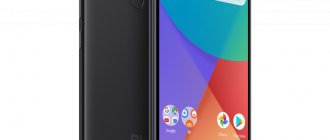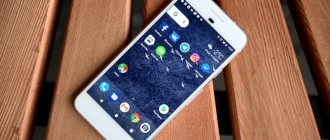Specifications
- Screen: 5.2”, IPS, 423ppi, 1920 x 1080, Gorilla Glass 3;
- Operating system: Android 6.0.1 Marshmallow;
- Processor: Qualcomm Snapdragon 808 (MSM8992), 2 x Cortex-A57 2.0 GHz, 4 x Cortex-A53 1.5 GHz;
- GPU: Adreno 418;
- RAM: 2 GB (LPDDR3);
- Built-in memory: 16 GB;
- Cameras: Main camera: 12.3 MP, (F2.0, 1.55 micron sensor, laser autofocus, dual LED flash), 5 MP;
- Battery: 2700 mAh, built-in;
- Dimensions (WxHxT): 147 x 72.6 x 7.9 mm;
- Weight: 136 grams;
- SIM slots: 1, Nano-SIM;
- Communication: GSM 1800/1900/900, UMTS 1900/2100/850/900, LTE 1700/2100/1900/2300/2500/2600/800.
Review and testing of the LG Nexus 5 smartphone
Table of contents
- Introduction
- Specifications
- Packaging and delivery
- Appearance and design
- Display
- Communication capabilities
- Performance
- File system
- Battery
- Software and multimedia
- Camera
- Conclusion
Introduction
In this review we will talk about the fifth generation of “purebred Googlephones”.
Google started this tradition in January 2010 with the release of HTC's Nexus One. That device was equipped with a single-core processor with a frequency of 1 GHz, 512 MB of RAM and a small 3.7-inch display, and there was no front camera at all. In December of the same year, Google presented a new version of the “Google Phone” - Nexus S. This time the order went to Samsung, which gave birth to a phone very similar in characteristics to its predecessor, adding NFC, a larger display and a front camera. Almost a year later, in October 2011, a new generation of the device was released, again under the Samsung brand. It was the Galaxy Nexus with a dual-core 1.2 GHz processor made by Texas Instruments, one gigabyte of RAM and a 4.6″ HD display.
After him, the baton was passed to LG along with an order for the Nexus 4, the main innovations of which were a quad-core Qualcomm processor, two gigabytes of RAM and an improved eight-megapixel camera. But more than a year had passed since that moment and the market demanded a new step from the software giant. It was LG Nexus 5.
Specifications
- Processor: 2.2 GHz, quad-core Qualcomm Snapdragon 800;
- Video processor: Adreno 330;
- Operating system: Android 4.4 KitKat;
- Memory: 2 GB RAM, 16 GB internal memory;
- Screen: touch IPS, 4.95″, 1920 x 1080px, 445ppi;
- Camera: 8 MP, front 1.3 MP;
- Network: GSM 900/1800/1900, 3G, LTE (only the D821 model works in Russia);
- Battery: 2300 mAh;
- Dimensions: 138 x 70 x 8.6 mm;
- Weight: 130 g;
- Price: from 17,500 rubles for D820, from 19,000 rubles for D821.
Quite a good filling, which is enough for most tasks today. The only thing that scares us is the relatively weak battery, but more on that later.
Packaging and delivery
announcements and advertising
2080 Super Gigabyte Gaming OC for 60 rubles.
Compeo.ru - the right comp store without any tricks
RTX 2060 becomes cheaper before the arrival of 3xxx
Ryzen 4000
series included in computers already in Citylink
The price of MSI RTX 2070 has collapsed after the announcement of RTX 3xxx
Core i9 10 series is half the price of the same 9 series
The price of memory has been halved in Regard - it’s more expensive everywhere
Along with the phone, the user receives:
- Micro-USB cable;
- Charger (model MCS-01ED; input voltage: 100-240 V ~50/60 Hz, 0.2 A, output voltage: 5 V 1.2 A);
- Documentation and warranty card;
- “Paper clip” for removing the SIM card.
Yes, there is no error here: the headset is not included in the delivery. At least in the case of the D821 model, which was in my hands. Charging is quite low - 1200 mAh, so a full charge will take about two hours. The wire is standard: not as thick as that of Nokia or NTS, but not as thin as that of the Chinese like Keneksi.
The packaging is made of thick pressed cardboard with a print in a minimalist style, in pastel colors. The front side shows part of the smartphone with abstract “wallpaper” on the display. The contents are removed by pushing the tray out of the box.
The smartphone itself lies in this “crib”:
The display is protected from scratches by a film (it must be admitted that it is very thick).
Appearance and design
In terms of size, the Nexus 5 can be compared with the HTC One, Samsung Galaxy S4 and Nokia Lumia 925. In terms of thickness, it is on par with the Samsung model and slightly thinner than the Lumia.
Corning brand glass was used. The back side is flat, with a Soft-touch coating. Holding the gadget in your hand is quite comfortable, the sensations are very similar to those you experience when you hold OPPO Find 5 and HTC One.
The camera location is completely covered with glass, the flash consists of one LED, and the lenses are coated. The Nexus inscription is embossed and made in gloss, just like the LG logo. The IMEI sticker can be easily removed. Just below the logo is the inscription “Made in Korea”.
In general, the appearance of the smartphone can be called strict; it is suitable for those who do not want to “shout” about the brand of their device to everyone they meet. In the case, this phone is very difficult to distinguish from the mass of other models, unlike the same NTS One. Whether this is a plus or a minus is a purely subjective question.
The build quality is not satisfactory: there are practically no creaks or gaps, no traces of glue are visible. The case is non-separable, so it will be difficult to change the battery yourself if the latter fails.
The camera's optics protrude slightly from the body, so unless you wear a thick enough case to compensate for this protrusion, you can damage the glass covering the lenses.
The speaker and microphone slots on the body are very similar to those of the iPhone 5(C/S). The speaker is located on the left, the microphone on the right. The white LED is located exactly in the center, below the screen.
The volume rockers are located on the left, so it will be very convenient to use them during a conversation (if you are right-handed), and vice versa in player mode. The key travel is small and clear, there is some play, but within reason (a similar one was seen on the iPhone 5S).
The front camera is located in the left corner, the headphone jack is pressed against the cover. In general, the AUX connector on the top of the smartphone is, in my opinion, a controversial decision. There is a display switch-off sensor, and a microphone for noise reduction is visible at the end.
The lock button is similar to the volume rocker. The micro-SIM card slot is very similar to those used in other smartphones and does not stand out in any way.
Appearance
To say that the Nexus line has never stood out with its catchy appearance would not be correct. Still, Nexus 6 from Motorola looked original, and the periscope-like Huawei Nexus 6P is visually interesting. But in the case of the LG Nexus 5X, the similarities with earlier models that had a nicely simple design are obvious. Before us is a laconic plastic monoblock.
The front panel is covered with tempered Gorilla Glass 3, surrounded by an edging that is barely visible to the touch. In the upper part you can easily see the camera and the proximity/light sensor unit, but it is impossible to notice the LED indicator until it lights up - it is hidden in the center of the main speaker slot and winks beautifully from under its grille. Separately, we note that the Nexus 5X is not equipped with stereo speakers, as it might seem, they play separately.
We didn't notice any problems with the build quality, but we didn't like the mechanical keys. Despite the clear movement, their shape itself is not very pleasant tactilely. If we turn to the opposite side of the smartphone, we should note the presence of a fingerprint sensor, and of course the camera, accompanied by a dual LED flash and laser autofocus.
Its protruding mound somewhat negatively affects ergonomics, since a smartphone lying on a table can sway when pressed on the screen. Judging by the no longer new test sample, the materials used are durable and resistant to damage.
Display
The 5.2-inch IPS matrix occupies about 70% of the front panel of the Nexus 5X, and if the side frames do not exceed three millimeters, the top and bottom margins are large. The top one is a little smaller, and the bottom one is only one and a half centimeters. This is where the disadvantages of the screen end. Recognition of 10 simultaneous clicks, good grease-repellent coating, correct brightness adjustment, but most importantly, excellent image.
Almost ideal color gamut, natural picture, sufficient brightness, uniform illumination, no color inversion and a weak Glow effect. The only thing that the naked eye can catch on is the highlighting of black color with a strong deviation from the perpendicular, but I wouldn’t dare call this a serious drawback. Like the Huawei Nexus 6P, Ambient Display technology works here. On an IPS screen it doesn’t look as impressive as on an AMOLED screen, but it’s still useful.
Iron
For the Nexus 5X, the manufacturer chose a six-core Snapdragon 808 processor with an Adreno 418 graphics accelerator. 16 or 32 gigabytes are available for installing applications, depending on the version of the smartphone. This is a powerful configuration, which will not become obsolete any time soon, even despite the 2 GB of RAM and the poor architecture.
The stability of the chip has to be ensured through throttling - a decrease in performance as the chip heats up. It is clearly visible in a continuous series of several benchmark runs, where the difference between the first, cold start and the fifth run is about 17%. The heating of the case remains within the comfortable range.
The Nexus 5X's fingerprint scanner is fast, but its functionality is limited to turning on the smartphone and confirming Android Pay payments. There is no option to block individual applications or use it as a touchpad.
NEXUS 6
The sixth in a row was the Nexus 6 from Motorola. The smartphone was presented on October 15, 2014. It became the first smartphone on “material” Android 5.0 Lollipop. This smartphone belongs to the phablet category. It has a 5.96-inch QHD AMOLED display and 3GB of RAM, and it is also splash-proof. Unfortunately, it has not regained the former popularity of the Nexus 5.
Specifications:
- Operating system: Google Android 5.0 Lollipop
- Display: capacitive, 5.96 inches, 1440×2560 pixels, AMOLED, 493 ppi, Corning Gorilla Glass 3
- Camera: 13 megapixels, dual flash, autofocus, video recording [email protected]
- Front camera: 2 megapixels
- Processor: quad-core Qualcomm APQ8084 Snapdragon 805 clocked at 2.7 GHz
- Graphics accelerator: Adreno 420
- RAM: 3GB
- Internal memory: 32GB or 64GB
- Memory card: not supported
- A-GPS and GLONASS
- Wi-Fi 802.11 a/b/g/n/ac
- Bluetooth 4.1
- microUSB 2.0
- 3.5mm headphone jack
- NFC
- Qi wireless charging
- Battery: Li-Po, 3220 mAh
- Dimensions: 159.3x83x10.1 mm
- Weight: 184 grams
Software
The Nexus line retains its main feature - a perfectly optimized operating system that receives priority updates from Google developers. At the time of writing this review, this is Android 6.0.1 Marshmallow, however, the Android N Developer Preview version is already available for download and installation.
Android on the Nexus 5X uses RAM sparingly, works quickly and stably, but at the same time is very minimalistic and inferior in functionality to many other Android-based firmware. However, for an experienced user, if desired, it will not be a problem to install third-party firmware, choosing from the huge variety currently available.
Galaxy Nexus
The popularity of the Nexus grew along the curve with each new generation, the Galaxy Nexus became the first device based on Android 4.0 Ice Scream Sandwitch, which set a new tone for the system from Google. Based on the Galaxy S2, the Galaxy Nexus has a dual-core 1.2 GHz processor, 1 GB of RAM, and a large 4.65-inch curved AMOLED display with HD resolution. However, due to legal proceedings with Apple, sales had to be frozen from June 29 to July 6. It is worth noting that the announcement of the device, scheduled for October 5, was postponed due to the death of Steve Jobs, but it was presented on October 19, 2011 and went on sale a month later, this cannot but say about Google’s attitude towards its opponent Steve, they understood , what contribution this person made to the history of the mobile market. One of Samsung's lawyers described sales of the Galaxy Nexus as "very meager", believe him or not, it's up to you to decide.
Connection
LG Nexus 5X is equipped with a set of wireless interfaces that meets all the latest trends. There is Bluetooth 4.2 (A2DP, low energy, Apt-X), and dual-band (2.4 - 5 GHz) Wi-Fi 802.11a/b/g/n/ac, GPS/A-GPS, Glonass and NFC. There is one SIM card slot.
There are no problems with calls or data transfer. Noise reduction works correctly. The earpiece sounds good, but the main one at maximum volume is disappointing - especially intense music tracks make it wheeze. It's a completely different matter in high-quality headphones - clean high frequencies, pronounced low frequencies, a balanced sound stage.
Connection to a computer is carried out using symmetrical USB 2.0 Type C, supporting OTG technology.
NEXUS 5
The fifth smartphone was Nexus 5 from LG. The most popular and most successful smartphone in the line at the moment. He can also be called legendary. Until now, people buy it, and those who have already bought it do not want to exchange it for another smartphone, because this is the best solution in terms of price/quality standard. This smartphone was presented to the public on October 31, 2013. The device came with the latest version of Android 4.4 KitKat, an official update to Android 6.0.1 Marshmallow is already available, and, according to preliminary data, the smartphone will soon receive an official update to Android N, which is currently being tested in Beta version. The characteristics at the end of 2013 were flagship, and it itself was supplied by the company as a flagship, and there is no point in arguing here. It still handles the heaviest games and programs with ease. It has a 4.95 inch True HD IPS+ display and 2GB of RAM.
Specifications:
- Operating system: Google Android 4.4 KitKat
- Display: capacitive, 4.95 inches, 1080x1920 pixels, True HD IPS+, 445 ppi, Corning Gorilla Glass 3
- Camera: 8 megapixels, flash, autofocus, video recording [email protected]
- Front camera: 1.3 megapixels
- Processor: quad-core Qualcomm MSM8974 Snapdragon 800 clocked at 2.3 GHz
- Graphics accelerator: Adreno 330
- RAM: 2GB
- Internal memory: 16GB or 32GB
- Memory card: not supported
- A-GPS and GLONASS
- Wi-Fi 802.11 a/b/g/n/ac
- Bluetooth 4.0
- microUSB 2.0
- 3.5mm headphone jack
- NFC
- Qi wireless charging
- Battery: Li-Po, 2300 mAh
- Dimensions: 137.9×69.2×8.6 mm
- Weight: 130 grams
Battery
The LG Nexus 5X has a non-removable battery with a capacity of 2700 mAh, which is basically enough for a long working day. The Trashbox test for battery life in the Chrome browser takes 11 hours and 47 minutes. Qualcomm Quick Charge also makes life easier for the user. The battery is half full in 40 minutes. It takes 2 hours to fully charge.
Camera
The Google Phone in question has a front-facing 5-megapixel wide-angle camera and a 12.3-megapixel main sensor.
First, about the selfie camera. It is, frankly speaking, average in terms of image quality and does not stand out from its competitors in anything special. As for the main photo module, you can forgive its protruding shape for the quality of the images.
We are talking about Sony IMX377, a sensor in all respects identical to that installed in the Nexus 6P. As we've already said, this solution is significantly better than the vast majority of 13 MP cameras we've encountered.
The Nexus 6P shot excellently and the Nexus 5X is almost as good. Some differences are due to the use of a weaker CPU. Thus, there is no EiS electronic image stabilization, and in HDR mode you can take a series of only three pictures, and their processing will not happen instantly, but will take some time. At the same time, frames in HDR, compared to shooting by default, change dramatically; the mode copes with insufficient lighting very effectively.
The pre-installed camera application is minimalistic and will not allow the user who is inexperienced in photography to get confused in the settings. If desired, you can use alternative solutions with support for the new API, which allows, among other things, shooting in RAW.
Installing stock firmware on Nexus 5
- We put the Nexus 5 into Fastboot mode:
- Turn off the smartphone.
- Press the Power + “Volume -” button for 10 seconds, fastboot starts
- Connecting the device to the computer
- Unpack the archive with the firmware into the ADB folder. It is necessary that you unpack not a folder into a folder, but rather the files that are in the archive with the firmware into the folder with ADB. If this point is not entirely clear, you can watch the video.
- Go to the folder with ADB (my ADB folder is located at the following path “D:\ADB”). And run the file flash-all.bat
We are waiting for the firmware to finish
Let's sum it up
The Nexus 5X is an outwardly discreet device with great potential, in which we especially note the main camera and excellent screen. Its most significant drawback is not even the Snapdragon 808, which noticeably loses performance when heated, or its simple design, but the high cost at the start of sales. As the price drops, the Nexus 5X looks more and more attractive, especially since the lifespan of this line is obviously longer than that of most smartphones due to direct updates from Google.
Pros:
- Great camera;
- High-quality FHD display;
- Fingerprint sensor;
- Constantly updated and perfectly optimized OS.
Minuses:
- Throttling;
- Main mono speaker.
May not like:
- Minor problems with the ergonomics of the case;
- Discreet appearance;
- The USB Type-C connector is still rarely used.
Final score: 6 out of 10.
Nexus 7 (2013)
The second generation, introduced in 2013, became even better: the tablet received a Snapdragon S4 PRO, according to some rumors, it was a defective Snapdragon 600 operating at low frequencies, 2 GB of RAM, a 7-inch FullHD display, excellent design and a nice body, and also Android 4.3 on board, which was recently updated to Android Lollipop. The 2013 Nexus 7 became Google's most popular tablet, with the company charging just $229 for 16GB and $269 for 32GB for those specs.











